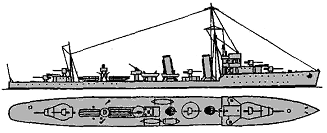
NAVYPEDIA
 Support the project with paypal
Support the project with paypal
Ships
| Name | No | Yard No | Builder | Laid down | Launched | Comp | Fate |
|---|---|---|---|---|---|---|---|
| Stuart | D00 | Hawthorn Leslie, Hebburn, UK | 10.1917 | 22.8.1918 | 12.1918 // 10.1933 | BU 2.1947 |
Technical data
| Displacement normal, t | 1580 |
|---|---|
| Displacement full, t | 2050 |
| Length, m | 101.3 |
| Breadth, m | 9.68 |
| Draught, m | 3.81 |
| No of shafts | 2 |
| Machinery | 2 sets Brown-Curtis geared steam turbines, 4 Yarrow boilers |
| Power, h. p. | 40000 |
| Max speed, kts | 36 |
| Fuel, t | oil 500 |
| Endurance, nm(kts) | 5000(15) |
| Armament | 5 x 1 - 120/45 BL Mk I, 1 x 1 - 76/45 20cwt QF Mk II, 2 x 1 - 40/39 2pdr QF Mk II, 2 x 3 - 533 TT, 2 DCT, 1 DCR |
| Electronic equipment | type 124 or type 127 sonar |
| Complement | 164 |
Standard scale images

Stuart 1933
Project history
A design of flotilla leader was prepared in the spring of 1916 to incorporate features of the Shakespeare class, but using standard Admiralty practice so that contracts could be given to other builders. It was suggested that Thornycroft's drawings should be given to Cammell Laird to enable them to achieve similar weight-rediuctions and Barrington and Hughes were in fact ordered to the Shakespeare design, but the DNC advised against this move as non-specialist builders were unlikely to be able to achieve similar standards, and the two were subsequently changed to standard Admiralty leaders. The design was very similar to the Shakespeare, but they were heavier and slower. On her acceptance trials Scott reached about 33kts at a displacement of 1716t. and in a comparative trial reached 36.63kts at 1770t. Machinery weighed about 70t more than in the Thornycroft boats. Externally the major difference was the funnels, which were round in the Admiralty design, instead of flat-sided. Scott was ordered in April 1916, followed by Bruce and Douglas in December, and the remainder in April 1917.
Designs were originally developed by Admiralty and Thornycroft (originally they had to be armed by 6 102mm guns) in parallel, but then it was decided to unify design as much as possible, Thornycroft design was a little redesigned, being armed by 5 127mm guns (as in the Admiralty variant). Soon 127mm guns in both designs were replaced by Army 120mm which adapted for sea conditions (127mm guns were then on a paper only). 2 40mm AA pompoms, 6 TT and 1 76mm AA gun supplemented armament.
Modernizations
mid-1930s: - 2 x 1 - 40/39
early 1941: - 2 x 1 - 120/45 ("Q" & "Y"); + 4 x 1 - 20/65 M1940 (Italian), 2 DCT, 2 DCR
1942: - 2 x 3 - 533 TT, 1 x 1 - 20/65; + 2 x 1 - 40/39 2pdr QF Mk VIII
1942 - 1944, presumably: + type 271, type 285, type 286 radars
1944: was converted to APD: 2 boilers were removed and their room was converted to accommodation for marines; - 2 x 1 - 120/45, 1 x 1 - 76/45, 3 x 1 - 20/65, 4 DCT, 3 DCR; + 1 x 1 - 40/39 2pdr QF Mk VIII, 7 x 1 - 20/70 Oerlikon Mk II/IV
Naval service
No significant events.
 HOME
HOME FIGHTING SHIPS OF THE WORLD
FIGHTING SHIPS OF THE WORLD AUSTRALIA
AUSTRALIA TORPEDO SHIPS
TORPEDO SHIPS STUART destroyer leader (1918/1933)
STUART destroyer leader (1918/1933)
